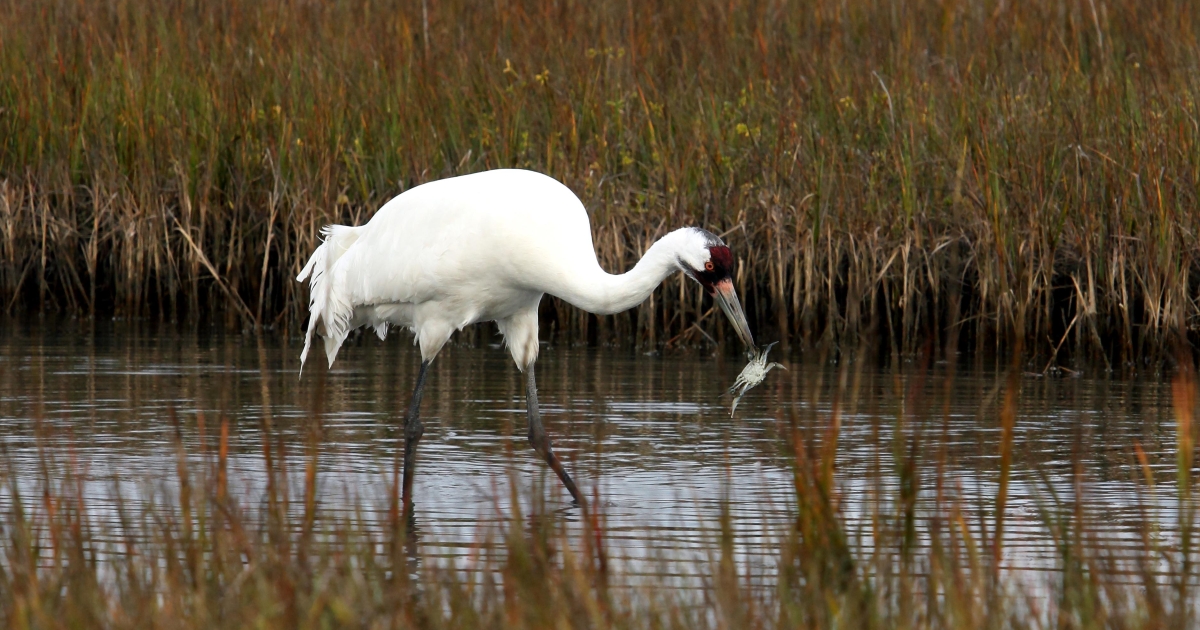Whooping cranes need wetlands with shallow water for foraging and roosting to survive in their habitat. These habitats provide the cranes with food, shelter, and safety from predators.
The cranes require a variety of food sources, including plants, insects, crustaceans, and small vertebrates, which are abundant in wetlands. Wetlands also provide safe nesting sites, and the cranes use vegetation and water to build nests and raise their young.
Unfortunately, habitat loss and degradation, human disturbance, and hunting have severely impacted whooping crane populations. Conservation efforts, such as wetland restoration and protection, are crucial for the survival of whooping cranes and their habitats.

Credit: www.fws.gov
Physical Needs Of Whooping Cranes
Whooping cranes are a unique species that require specific needs to survive in their habitat. Understanding their physical needs is crucial to help conserve these magnificent birds for future generations. Here are the key points about the physical requirements of whooping cranes:
Food Sources And Feeding Habits
Whooping cranes are omnivorous birds that feed on a variety of foods. Here are some important points to consider regarding their diet:
- Cranes primarily feed on small aquatic animals such as insects, fish, frogs, and crustaceans.
- During the growing season, cranes may also feed on agricultural crops, grains, and berries.
- Whooping cranes prefer open areas with shallow water, where they can forage for food.
- They use their long bills to probe and dig for food in mud and shallow water.
Water And Shelter Requirements
Whooping cranes rely on water and shelter to survive in their habitat. Here are the key points to consider regarding their water and shelter needs:
- Cranes depend on wetlands, shallow lakes, and rivers for water sources. These environments provide ample food sources and protection from predators.
- Cranes require protected areas for nesting, resting, and roosting, such as marshes or grassy fields.
- They prefer shallow water with muddy bottoms, as it provides suitable habitats for their food sources.
- During migration, cranes require stopover sites where they can rest and refuel before moving on.
Whooping cranes require suitable food sources and shelter to survive in their habitat. Understanding their physical needs is essential to protect the species from extinction. By providing these requirements, we can preserve the unique and endangered wildlife that is the whooping crane.
Mating And Reproductive Needs Of Whooping Cranes
Mating And Pair Bonding
Whooping cranes are monogamous birds that mate for life, and their pair bonding begins early in life. Here are key points about their mating habits and pair bonding:
- Whooping cranes form pair bonds at the age of two, and their bond lasts an average of 22 years.
- The courtship behavior of whooping cranes involves calls, head-bobbing, and dancing.
- Male cranes usually initiate the dance, and the female responds with a similar dance step.
- Once they become a pair, they continue to dance together, fly together, and roost together.
- Whooping cranes usually mate between april and june, and they don’t mate every year.
- Whooping cranes become sexually mature at three to five years of age.
Reproductive Behaviors And Nesting
The reproductive behavior and nesting of whooping cranes are critical factors in their survival. Here are key points about their reproductive behaviors and nesting:
- Whooping cranes generally lay one to two eggs each year.
- Female cranes choose the nest location, which can be in a marsh, pond, or wet prairie.
- The nesting site is usually in shallow water, and the nest is made of rushes, cattail, and other marsh plants.
- Both male and female cranes take turns incubating the eggs, which hatch in about 30 days.
- Once the chicks hatch, they stay with their parents for about ten months.
- Whooping cranes raise their chicks on a diet of insects, small invertebrates, and fish.
Whooping cranes’ mating and reproductive behaviors are essential for the species’ survival. By understanding these behaviors, we can ensure their continued existence in the future.
Conservation Strategies For Whooping Crane Protection
Historical And Modern Threats To Habitat And Populations
Whooping cranes face a multitude of threats, both historical and modern, that have endangered their populations and their habitats. Below are some of the most critical historical and modern threats to their survival.
- Habitat loss: The conversion of wetlands for agricultural or urban development is the most significant factor affecting whooping crane habitat loss. This has caused the habitat to become fragmented, resulting in various problems for the species.
- Human disturbance: Human activity in breeding and migratory areas is a significant threat to the species. Disturbances like noise and disturbance by humans with aircraft or various watercraft activities can cause the bird’s nesting and caring behavior to change, leading to predation and disturbance by other birds.
- Climate change: Climate change has led to changes in the timing of migration, as well as shifting breeding grounds and predation times. Changes in temperature and precipitation patterns can impact the whooping crane’s food and habitats, causing conflicts in food supply.
Current Conservation Efforts
To protect the whooping crane, various conservation strategies and efforts are in place worldwide. Here are some current conservation efforts that are essential for their survival.
- Habitat conservation: Conservation organizations establish protection measures for essential breeding and migratory locations, where the bird can breed and feed with minimal human disturbance.
- Legal protection: Whooping cranes are legally protected under various federal and state regulations, making it illegal to kill or capture them.
- Education and awareness: Consciousness about whooping cranes, their habitat, and their environment is vital in protecting them. Education of the public and even children helps to advocate for serious discussions about risks and impacts.
- Scientific research: Continued scientific research helps to understand specific issues and challenges facing the species’ survival, such as breeding issues, habitat changes, and changes in migration patterns.
- Implementation of conservation plans: Various conservation plans have been launched globally to conserve whooping cranes and their habitat. These plans focus on controlling human-caused impacts, enhancing natural habitats, and ensuring local government cooperation and harmonization with conservation objectives.
Whooping cranes face numerous threats to their existence, including habitat loss, human disturbance, climate change, and predation. Various conservation strategies are underway to safeguard them from extinction, including legal protection, continued scientific research, habitat conservation, and education and awareness-raising. These efforts need to be continued and improved to ensure that the species survives for future generations.
Frequently Asked Questions Of What Do Whooping Cranes Need To Survive In Their Habitat?
What Do Whooping Cranes Eat In The Wild?
Whooping cranes mainly eat small animals, insects, fish, and occasionally, plants. Their diet varies depending on the season and availability of food. They find their food in shallow waters and marshes.
Why Are Whooping Cranes Endangered?
Whooping cranes are endangered due to habitat loss, hunting, and low breeding rates. Their slow reproduction rate also makes them vulnerable to extinction. Conservation efforts have helped increase their numbers in recent years.
What Is The Habitat Of Whooping Cranes?
Whooping cranes live in wetlands, marshes, and grassy areas. They migrate along the central flyway, stopping at natural wetlands and other wetland habitats. They need an area with shallow water and plentiful vegetation to thrive.
How Long Do Whooping Cranes Live?
Whooping cranes can live up to 24 years in the wild. They reach maturity at the age of four and typically mate for life. Their low reproduction rate and slow maturation make their survival difficult.
What Are The Threats To Whooping Crane Habitat?
Human activities such as mining, oil and gas drilling, and construction pose a significant threat to the whooping crane habitat. Additionally, the degradation of wetlands and grasslands due to climate change is a concern. Proper conservation strategies can mitigate these threats.
Conclusion
It is clear that whooping cranes require specific components in their habitat in order to survive and thrive. Protection from predators, ample food sources, varied habitats, and water access are crucial to the success of the species. As we continue to understand the complexities of their habitat and behaviors, we can work towards providing the best conditions for their survival.
Conservation efforts have brought the whooping crane population back from the brink of extinction, but the species remains vulnerable. The collaborative efforts of scientists, wildlife managers, and the general public will be essential in ensuring the ongoing success of the whooping crane.
By continuing to protect and restore their habitat, we can help ensure that these majestic birds continue to soar in the skies for generations to come.
Latest Posts
The Ultimate List: Top 8 Best Birdwatching Podcasts for Avid Birders
Looking for the top birdwatching podcasts? Here are the eight best options to tune into today! Birdwatching can be a thrilling, immersive experience that brings...
Stop Squirrels in Their Tracks: 10 Effective Ways to Safeguard Your Bird Feeder Pole
To prevent squirrels from climbing your bird feeder pole, use squirrel baffles and slippery poles. Here are ten effective ways to keep squirrels from stealing bird food and damaging bird feeders. ...


